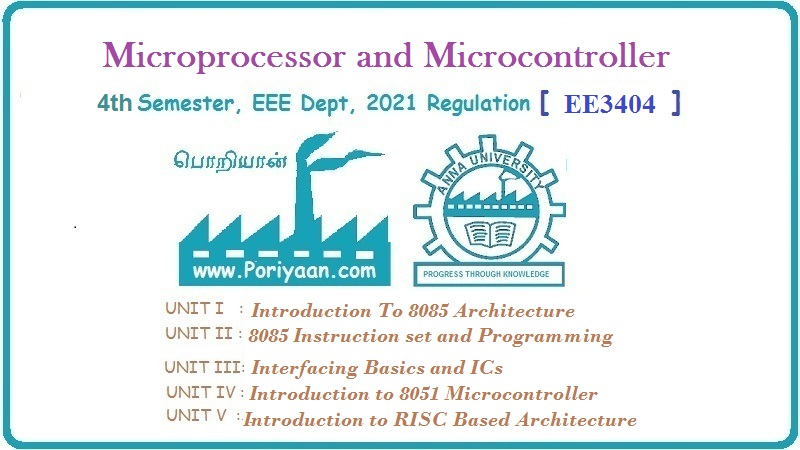Microprocessors and Microcontrollers: Unit II: (a) 8085 Instruction Set and ALP
Programming Examples
Question : 1. Describe with a suitable 8085 assembly language program the use of subroutine instructions.
Programming Examples
Lab Experiment 2.5.1 : Store 8-bit data
in memory.
Statement :
Store the data byte 52H into memory location 2000H.
Program
1 :
MVI
A, 52H ; Store 52H in the accumulator
STA
2000H ; Copy accumulator contents
at address 2000H
HLT ; Terminate program execution
Program
2 :
LXI
H, 2000H ; Load HL with 2000H
MVI
M, 52H ; Store 52H in memory location pointed
; by HL register pair
(2000H)
HLT ; Terminate program execution
The
result of both programs will be the same. In program 1 direct addressing
instruction is used, whereas in program 2 indirect addressing instruction is
used.
Lab Experiment 2.5.2 : Exchange the
contents of memory locations.
Statement :
Exchange the contents of memory locations 1000H and 2000H
Program
1 :
LDA
1000H ; Get the contents of memory location 1000H into accumulator
MOV
B, A ; Save the contents in B register
LDA
2000H ; Get the contents of memory location 2000H into accumulator.
STA
1000H ; Store the contents of accumulator at address 1000H.
MOV
A, B ; Get the saved contents back into A register
STA
2000H ; Store the contents of accumulator at address 2000H
HLT
; Terminate program execution
Program
2 :
LXI
H, 1000H ; Initialize HL register
pair as a pointer
; to memory
location 1000H
LXI
D, 2000H ; Initialize DE register
pair as a pointer
; to memory
location 2000H
MOV
B, M ; Get the contents of memory location 1000H into B register
LDAX
D ; Get the contents of memory location 2000H into A register
MOV
M, A ; Store the contents of A register into memory location 1000H
MOV
A, B ; Copy the contents of B register into accumulator
STAXD
; Store the contents of A register into memory location 2000H.
HLT ; Terminate program execution
In
Program 1 direct addressing instructions are used, whereas in Program 2
indirect addressing instructions are used.
Lab Experiment 2.5.3 : Add two 8-bit
numbers.
Statement :
Add the contents of memory locations 2000H and 2001H and place the result in
memory location 2002H.
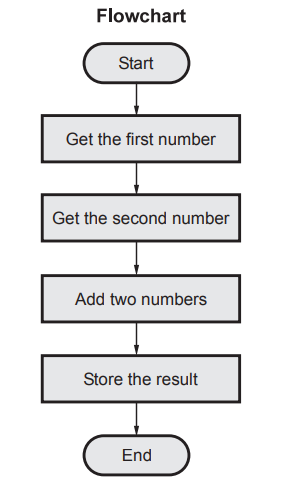
Sample
problem
(2000H)
= 14H
(2001H)
= 89H
Result
= 14H + 89H = 9DH
Source
program
LXI
H, 2000H ; HL points 2000H
MOV
A, M ; Get first operand
INX
H ; HL points 2001H
ADD
M ; Add second operand
INX
H ; HL points 2002H
MOV
M, A ; Store result at 2002H
HLT ; Terminate program execution
Lab Experiment 2.5.4 : Subtract two
8-bit numbers.
Statement :
Subtract the contents of memory location 2001H from the memory location 2000H
and place the result in memory location 2002H.
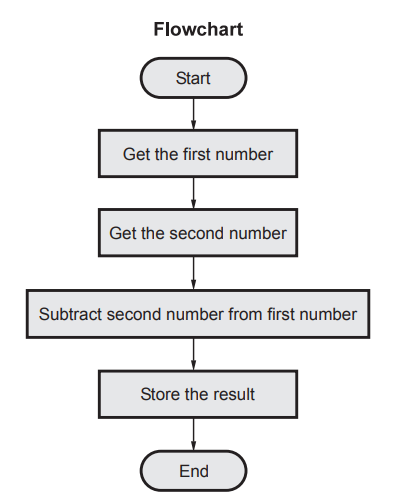
Sample
problem
(2000H)
= 51H
(2001H)
= 19H
Result
= 51H – 19H = 38H
Source
program
LXI
H, 2000H ; HL points 2000H
MOV
A, M ; Get first operand
INX
H ; HL points 2001H
SUB
M ; Subtract second operand
INX
H ; HL points 2002H
MOV
M, A ; Store result at 2002H
HLT
; Terminate program
;
execution
Lab Experiment 2.5.5 : Add two 16-bit
numbers.
Statement :
Add the 16-bit number in memory locations 2000H and 2001H to the 16-bit number
in memory locations 2002H and 2003H. The most significant eight bits of the two
numbers to be added are in memory locations 2001H and 2003H. Store the result
in memory locations 2004H and 2005H with the most significant byte in memory
location 2005H.
Sample
problem
(2000H)
= 15H
(2001H)
= 1CH
(2002H)
= B7H
(2003H)
= 5AH
Result
= 1015 + 5AB7H = 76CCH
(2004H)
= CCH
(2005H)
= 76H
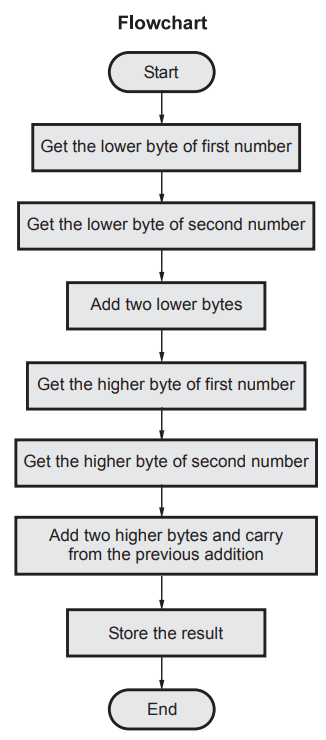
Source
program 1
LHLD
2000H ; Get first 16-bit number in HL
XCHG
; Save first 16-bit number in DE
LHLD
2002H ; Get second 16-bit number in HL
MOV
A, E ; Get lower byte of the first number
ADD
L ; Add lower byte of the second number
MOV
L, A ; Store result in L register
MOV
A, D ; Get higher byte of the first number
ADC
H ; Add higher byte of the second number
; with carry
MOV
H, A ; Store result in H register
SHLD
2004H ; Store 16-bit result in memory locations
; 2004H and 2005H.
HLT
; Terminate program execution
Source
program 2
LHLD
2000H ; Get first 16-bit number
XCHG
; Save first 16-bit number in DE
LHLD
2002H ; Get second 16-bit number in HL
DAD
D ; Add DE and HL
SHLD
2004H ; Store 16-bit result in memory locations
;
2004H and 2005H.
HLT
; Terminate program execution
In
program 1 eight bit addition instructions are used (ADD and ADC) and addition
is performed in two steps. First lower byte addition using ADD instruction and
then higher byte addition using ADC instruction. In program 2 16-bit addition
instruction (DAD) is used.
Lab Experiment 2.5.6 : Subtract two
16-bit numbers.
Statement :
Subtract the 16-bit number in memory locations 2002H and 2003H from the 16-bit
number in memory locations 2000H and 2001H. The most significant eight bits of
the two numbers are in memory locations 2001H and 2003H. Store the result in
memory locations 2004H and 2005H with the most significant byte in memory
location 2005H.
Sample
problem
(2000H)
= 19H
(2001H)
= 6AH
(2002H)
= 15H
(2003H)
= 5CH Result = 6A19H - 5C15H = 0E04H
Source
program
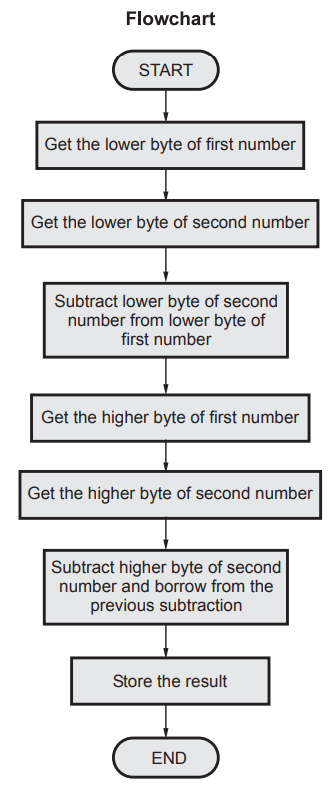
LHLD
2000H ; Get first 16-bit number in HL
XCHG
; Save first 16-bit number in DE
LHLD
2002H ; Get second 16-bit number in HL
MOV
A, E ; Get lower byte of the first number
SUB
L ; Subtract lower byte of the second number
MOV
L, A ; Store the result in L register
MOV
A, D ; Get higher byte of the first number
SBB
H ; Subtract higher byte of second
; number with borrow
MOV
H, A ; Store 16-bit result in memory
; locations 2004H and
2005H.
SHLD
2004H ; Store 16-bit result in memory
; locations 2004H and
2005H.
HLT
; Terminate program execution.
Lab Experiment 2.5.7 : Check results
after execution of INR B, INR C and INX B instructions.
Statement :
If the contents of B = FFH and C = FFH then after execution of following
instructions give the contents of register B and register C.

Lab Experiment 2.5.8 : Check results
after execution of OCR C, DCR B and OCX B instructions.
Statement : If
the contents of B = OOH and C = OOH then after execution of following
instructions give the contents of register B and register C.

Lab Experiment 2.5.9 : Find the 1's
complement of a number.
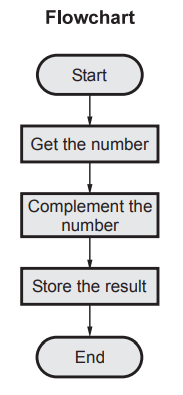
Statement :
Find the l's complement of the number stored at memory location 2200H and store
the complemented number at memory location 2300H.
Sample
problem
(2200H)
= 55H
Result
= (2300H) = AAH
Source
program
LDA
2200H ; Get the number
CMA ; Complement number
STA
2300H ; Store the result
HLT ; Terminate program execution
Lab Experiment 2.5.10 : Find the 2's
complement of a number.
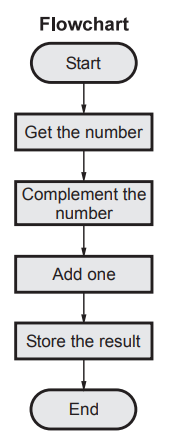
Statement :
Find the 2's complement of the number stored at memory location 2200H and store
the complemented number at memory location 2300H.
Sample
problem
(2200H)
= 55H
Result
= (2300H) = AAH + 1 = ABH
Source
program
LDA
2200 H ; Get the number
CMA
; complement the number
ADI,
01H ; Add one in the number
STA
2300H ; Store the result
HLT
; Terminate program execution
Lab Experiment 2.5.11 : Pack the two
unpacked BCD numbers.
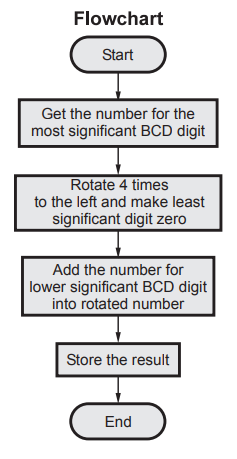
Statement :
Pack the two unpacked BCD numbers stored in memory locations 2200H and 2201H
and store result in memory location 2300H. Assume the least significant digit
is stored at 2200H.
Sample
problem
(2200H)
= 04
(2201H)
= 09
Result
= (2300H) = 94
Source
program
LDA
2201H ; Get the Most significant BCD digit
RLC
RLC
RLC
RLC ; Adjust the position
ANI
FOH ; Make least significant BCD digit
zero
MOV
C, A ; Store the partial result
LDA
2200H ; Get the lower BCD digit
ADD
C ; Add lower BCD digit
STA
2300H ; Store the result
HLT ; Terminate program execution
Lab Experiment 2.5.12 : Unpack the BCD
number.
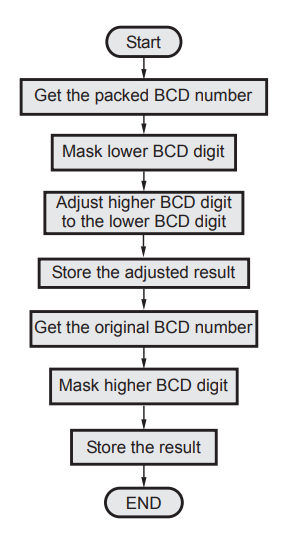
Statement :
Two digit BCD number is stored in memory location 2200H. Unpack the BCD number
and store the two digits in memory locations 2300H and 2301H such that memory
location 2300H will have lower BCD digit.
Sample
problem
(2200H)
= 58
Result
= (2300H) = 08 and (2301H) = 05
Source
program
LDA
2200H ; Get the packed BCD number
ANI
FOH ; Mask lower nibble
RRC
RRC
RRC
RRC ; Adjust higher BCD digit as a lower digit
STA
2301H ; Store the partial result
LDA
2200H ; Get the original BCD number
ANI
0FH ; Mask higher nibble
STA
2201H ; Store the result
HLT ; Terminate program execution
Lab Experiment 2.5.13 : Sample
subroutine program.
Statement :
Read the program given below and state the contents of all registers after the
execution of each instruction in sequence.
Main
program :
6000H LXI SP, 27FFH
6003H LXI H, 2000H
6006H LXI B, 1020H
6009H CALL SUB
600CH HLT
Subroutine
program :
6100H
SUB : PUSH B
6101H PUSH H
6102H LXI B, 4080H
6105H LXI H, 4090H
6108H DAD B
6109H SHLD 2200H
610CH POP H
610DH POP B
610EH RET
Solution
: The
Table 2.5.1 shows the instruction sequence and the contents of all registers
and stack after execution of each instruction.
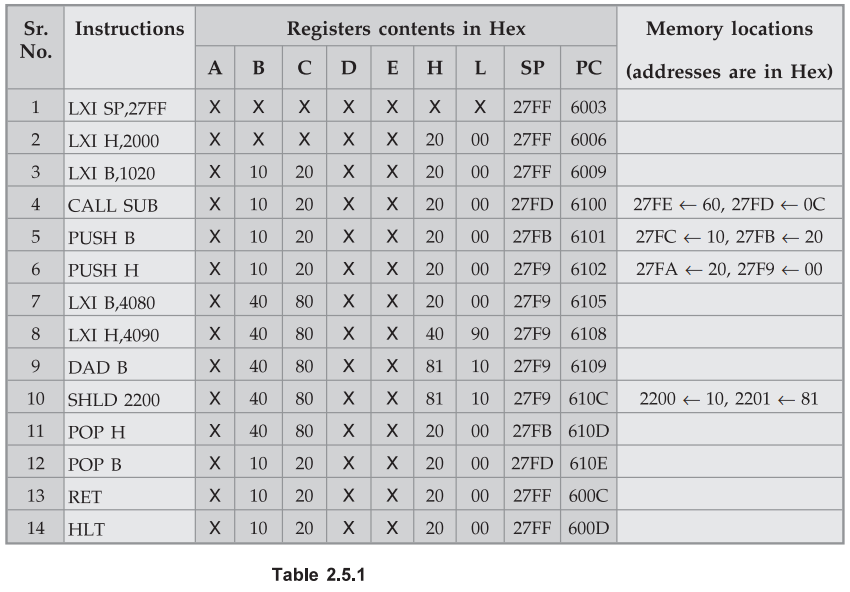
Lab Experiment 2.5.14 : Add contents of
two memory locations.
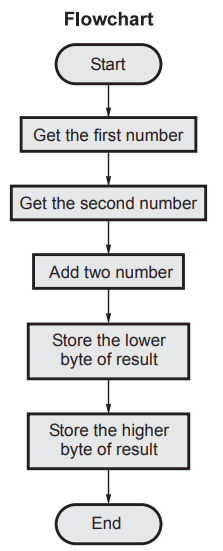
Statement :
Add the contents of memory locations 2000H and 2001H and place the result in
the memory locations 2002H and 2003H.
Sample
problem :
(2000H)
= 7FH
(2001H)
= 89H
Result
= 7FH + 89H = 108H
(2002H)
= 08H
(2003H)
= 01H
Source
Program
LXI
H, 2000H ; HL Points 2000H
MOV
A, M ; Get first operand
INX
H ; HL Points 2002H
MOV
M, A ; Store the lower byte of result at 2002H
MVI
A, 00 ; Initialize higher byte result with 00H
ADC
A ; Add carry in the high byte result.
INX
H ; HL Points 2003H
MOV
M, A ; Store the higher byte of result at 2003H
HLT
; Terminate program execution
Lab Experiment 2.5.15 : Right shift
data within the 8-bit register.
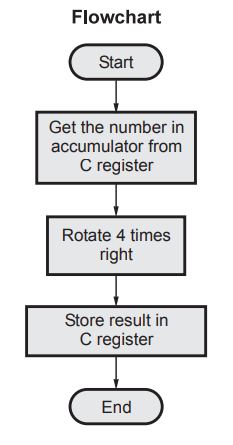
Statement :
Write a program to shift an eight bit data four bits right Assume that data is
in register C.
Source
program :
MOV
A, C
RAR
RAR
RAR
RAR
MOV
C, A
HLT
Lab Experiment 2.5.16 : Right shift
data within 16-bit register.
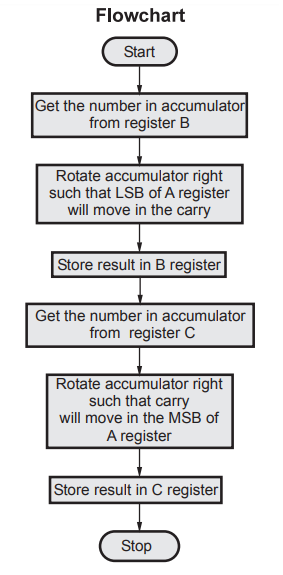
Statement :
Write a program to shift an 16-bit data 1 bit right. Assume data is in the BC
register pair.
Source
program :
MOV
A, B
RAR
MOV
B, A
MOV
A, C
RAR
MOV
C, A
HLT
Lab Experiment 2.5.17 : Left shift
16-bit data within 16-bit register.
Statement :
Write a program to shift an 16-bit data 1 bit left. Assume data is in the HL
register pair.
Sample
problem :
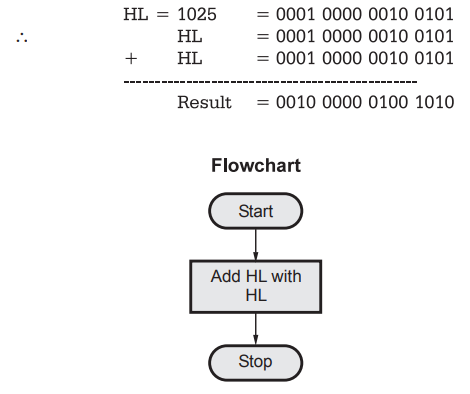
Source
program :
DAD
H
Lab Experiment 2.5.18 : Alter the
contents of flag register.
Statement :
Write a set of instructions to alter the contents of flag register in 8085.
Source
Program :
PUSH
PSW ; Save flags on stack
POP
H ; Retrieve flags in ‘L’
MOV
A, L ; Flags in accumulator
CMA ; Complement accumulator
MOV
L, A ; Accumulator in ‘L’
PUSH
H ; Save on stack
POP
PSW ; Back to flag register
HLT ; Terminate program execution
Lab Experiment 2.5.19 : Find 2's
complement of 16-bit number.

Source
Program :
LDA
2000H ; Load accumulator with contents of 2000H location
CMA
; Complement the lower byte
ADD
01H ; Add 01 to the accumulator
STA
4000H ; Store the accumulator data to 4000H location
LDA
2001H ; Load accumulator with data from memory location 2001H
CMA
; Complement the higher byte
ADC
OOH ; Add with carry to accumulator
HLT ; Stop
Lab Experiment 2.5.20 : Simulation of
CALL and RET instructions.
Statement : If
CALL and RET instructions are not provided in the 8085, could it be possible to
write subroutines for this microprocessor ? If so how will you call and return
from the subroutine ?
Solution
:
We know that,
1.
CALL instruction transfers the program control to the subroutine program by
loading the address of the subroutine program in the program counter, and
before transferring program control it saves the address of the instruction
after the CALL instruction on the stack.
2.
RET instruction loads the program counter with return address from the stack
and thus transfers the program control back to the instruction following the
CALL.
Now
our task is to implement the operation performed by these two instructions with
the help of other instructions of 8085.
Let
us implement RET instruction first. To implement this it is necessary to load
program counter with return address. To load program counter with 16-bit
address we have two instructions : JMP address and PCHL. But JMP address
instruction cannot be used for our purpose because JMP address loads program
counter with fix address and the return address is not fix, it depends on, from
where the subroutine is 'CALLed' in the main program. The other instruction,
PCHL loads 16-bit contents of HL register pair into PC. If we manage to load
return address into HL register pair, every time subroutine is called, then it
is possible to implement RET instruction with the help of
PCHL
instruction. We can load the HL register pair with return address before we
make a CALL for subroutine program.
The
task to implement CALL instruction is simplified because we are going to store
return address into the HL register pair before we make a 'CALL' for subroutine
program. Now it is only required to load program counter with the subroutine
address. This can be implemented by executing JMP instruction. Here JMP
instruction is suitable because subroutine starting address is a 'fix' address.
The table shows how we can 'Call' and 'Return' from the subroutine without
using CALL and RET instructions.
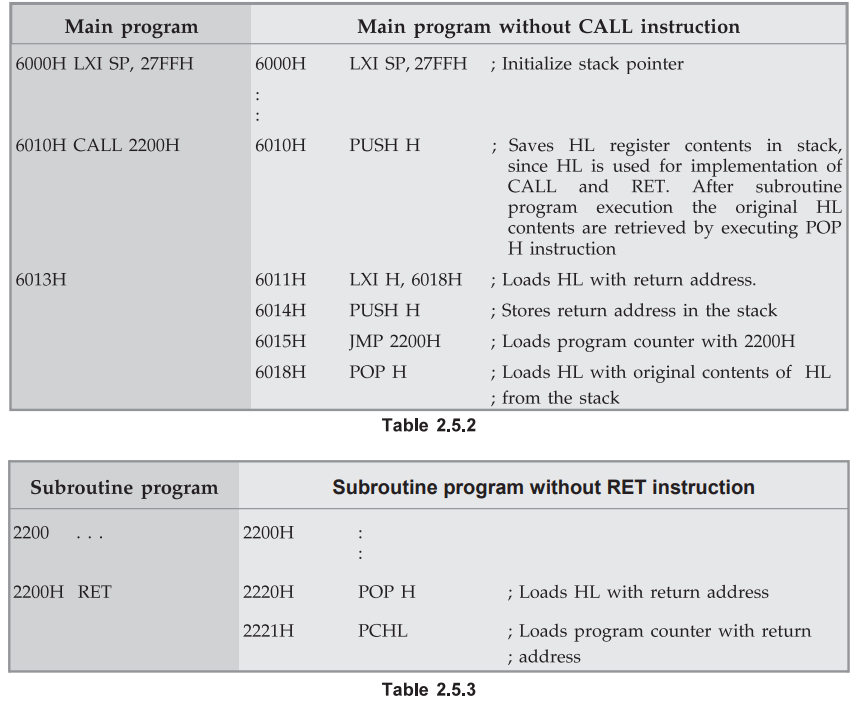
Review Question
1. Describe with a
suitable 8085 assembly language program the use of subroutine instructions.
AU : May-13, Marks 8
Microprocessors and Microcontrollers: Unit II: (a) 8085 Instruction Set and ALP : Tag: : - Programming Examples
Related Topics
Related Subjects
Microprocessor and Microcontroller
EE3404 MCU 4th Semester EEE Dept | 2021 Regulation | 4th Semester EEE Dept 2021 Regulation
